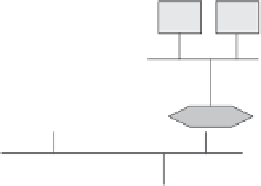Database Reference
In-Depth Information
CPU
CPU
CPU
CPU
CPU
CPU
CPU
CPU
Common Bus
Shared
Memory
Shared
Memory
Shared Memory
Shared Disks
Common Bus
Shared Memory
CPU
CPU
CPU
CPU
Shared Disks
Shared Disk
Shared Nothing
Figure 20-23
Parallel architecture options.
Shared Nothing
Each CPU has its own main memory and set of disks. Works well with an
operating system that supports transparent disk access. If a table or database
is located on a particular disk, access to it depends entirely on the CPU that
owns it. Internode communication is through CPU-to-CPU connection.
Parallel database systems speed up queries and transactions by executing them
in parallel. These systems support the following types of parallelism techniques.
I/O Parallelism
Database relations are partitioned horizontally or vertically, and
the data content is spread across multiple disks. Horizontal partitioning works well
for I/O partitioning. You may partition a relation into a number of horizontal
partitions and distribute the partitions to disks adopting the following techniques:
round-robin, hash distribution, or range partitioning.
When a query or transaction performs a retrieval of a set of rows or writing a set
of rows, performing the operation in parallel becomes possible through the I/O
parallelism technique. Full table scans, range selections, and value selections work
differently for different methods of distribution. For example, the round-robin
method is suited for sequential full table scans; value selection works well with hash
distribution; range partitioning applies well to range selections.
Interquery Parallelism
This form of parallelism increases system throughput.
Several queries or transactions execute in parallel. The queries are distributed
among several CPUs for running in parallel. Obviously, interquery parallelism
cannot be possible with single-processor systems. However, interquery parallelism
does not speed up individual queries or transactions. Each query by itself takes as
much time as it would in a single-processor system.
Shared-memory architecture works well for interquery parallelism. Supporting
interquery parallelism in the other architectures is more difficult.



















Search WWH ::

Custom Search